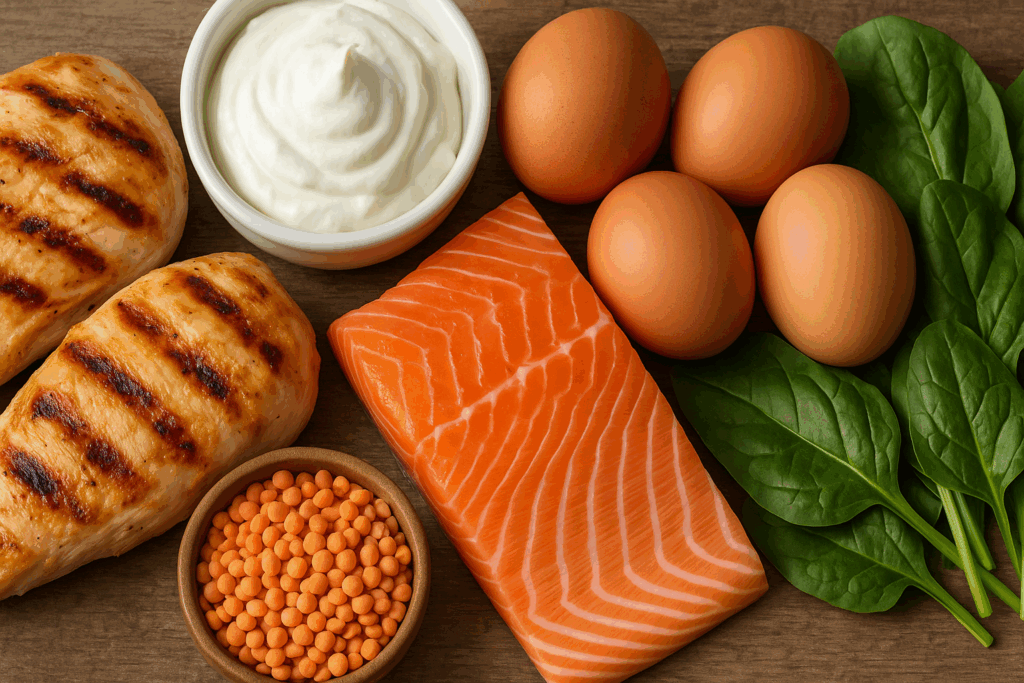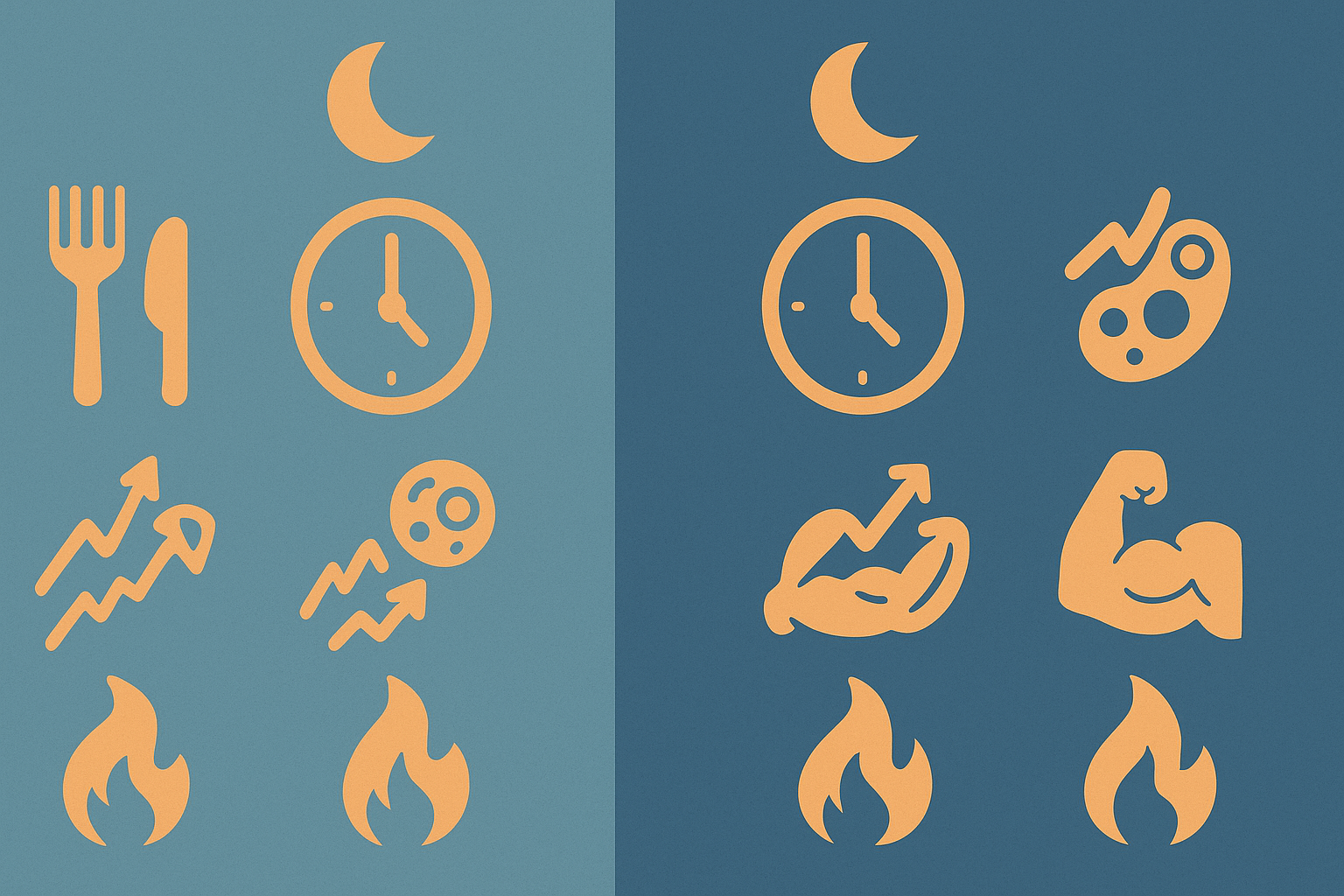Understanding intermittent fasting has become essential in today’s health-conscious climate, especially for those committed to high-protein nutrition plans. The debate surrounding intermittent fasting 14 10 vs 16 8 is growing more intense as each method finds its own tribe of followers. These two fasting schedules, while similar in structure, affect metabolism, hormonal regulation, muscle maintenance, and fat loss in slightly different ways. As more individuals turn to fasting as a method for sustainable weight control and improved body composition, particularly in tandem with high-protein diets, it becomes crucial to explore which strategy best supports overall health and fitness goals.
You may also like : The Ultimate Guide to Choosing a High Protein Diet Name That Fits Your Goals

What Is Intermittent Fasting and Why Does It Matter?
Intermittent fasting (IF) is not a diet in the conventional sense, but rather a pattern of eating that cycles between periods of fasting and eating. Among the many different forms of fasting, the 14 10 and 16 8 schedules have gained popularity for their simplicity and effectiveness. In the 14 10 format, individuals fast for 14 hours and eat within a 10-hour window, while the 16 8 approach restricts the eating window to just 8 hours, prolonging the fasting period by two hours. These small differences in timing may seem insignificant but can yield very different outcomes when it comes to muscle preservation, fat oxidation, and hunger hormone regulation.
Fasting is not a new concept. From ancient religious practices to modern metabolic research, the health benefits of fasting have been observed for centuries. Today, it has been shown that fasting benefits range from improved insulin sensitivity to reduced inflammation and even cellular repair processes. More specifically, when combined with a high-protein diet, intermittent fasting becomes a powerful tool for body recomposition. It supports lean muscle retention while promoting fat loss, an effect that is particularly pronounced in strategies like the 16 8 method, which forces the body into a deeper fasting state.

The Science Behind High-Protein Diets
A high-protein diet is typically defined as one where protein intake exceeds 25% of daily caloric consumption or approximately 1.6 to 2.2 grams of protein per kilogram of body weight. Protein is crucial for muscle growth, tissue repair, immune function, and satiety. When paired with intermittent fasting, protein takes on an even more critical role, as the body must maximize nutrient absorption and muscle preservation during shortened eating windows.
One major benefit of high-protein nutrition is its thermogenic effect. Digesting protein requires more energy than fats or carbohydrates, which leads to an increase in metabolic rate. This thermogenic advantage enhances the fat-burning effect of fasting, making schedules like 16 8 and 14 10 more potent. Furthermore, protein helps regulate appetite by reducing levels of ghrelin (the hunger hormone) and boosting peptide YY, which signals fullness. This appetite regulation becomes increasingly important during fasting periods, especially for beginners adapting to a beginner intermittent fasting schedule.
High-protein diets also support stable blood sugar levels, particularly when carb intake is strategically reduced or timed around workouts. This synergy between protein intake and metabolic control is one reason intermittent fasting is healthy for women and men seeking long-term body composition improvements.

Intermittent Fasting 14 10 vs 16 8: Exploring the Key Differences
At first glance, intermittent fasting 14 10 vs 16 8 might appear to differ only in length. However, those extra two hours of fasting in the 16 8 regimen can lead to significant physiological changes. In a 14-hour fast, the body begins to deplete glycogen stores and initiates mild fat oxidation. However, it’s during the extended fasting window of the 16 8 plan that the body enters a deeper state of ketosis, promoting more efficient fat-burning and autophagy—the process by which damaged cells are broken down and recycled.
When considering which plan supports high-protein nutrition best, the 16 8 schedule provides a more suitable environment for maximizing muscle growth and fat loss. This is because the longer fasting period enhances insulin sensitivity, allowing for more efficient nutrient partitioning during the feeding window. Individuals often report more significant fasting weight loss on the 16 8 schedule compared to the 14 10, especially when coupled with strength training and a high-protein food plan for intermittent fasting.
However, the 14 10 schedule may be more sustainable for beginners. Its shorter fasting period places less stress on the body and can reduce the risk of overeating during feeding windows. This makes it ideal for those just learning how to begin intermittent fasting or for individuals with higher calorie needs.

Muscle Preservation and Protein Timing Within Each Plan
One of the most pressing concerns among those combining intermittent fasting with strength training is the risk of muscle loss. Fortunately, studies show that high-protein intake during feeding windows can mitigate this risk. Protein timing becomes crucial here. In the 16 8 method, the condensed eating window allows for fewer meals, making it important to distribute protein strategically—such as consuming 30-40 grams of protein per meal.
For example, someone practicing a 16 8 fast might consume three meals of 40 grams of protein, spaced two to three hours apart. This structure supports muscle protein synthesis while avoiding catabolism. On the other hand, the 14 10 method allows for more frequent protein feedings, which may be advantageous for those with high protein needs or digestive challenges. It also offers a more flexible way to adhere to a food plan for intermittent fasting without feeling overly restricted.
Fasting Every Other Day and Longer Fast Variants
Some individuals experiment with more advanced forms of fasting, such as fasting every other day or undertaking 18 6 intermittent fasting or even a 20 hour fast. These schedules often induce more rapid fat loss but come with an increased risk of muscle loss if not carefully managed with a high-protein diet. While not sustainable for everyone, these approaches may be used cyclically or intermittently to break through fat loss plateaus.
When applying these more rigorous schedules, the importance of meal timing, protein quality, and recovery becomes paramount. For instance, during a 20 hour fast, muscle glycogen is significantly depleted. Replenishing with a complete protein source that includes leucine, an amino acid that triggers muscle protein synthesis, is essential. In these extended fasts, fasting benefits such as improved blood sugar control and hormonal regulation may be magnified, but they also require more advanced knowledge and self-regulation.

Hydration and What You Can Consume While Fasting
A common question among fasting newcomers is, “Can you drink water during intermittent fasting?” and its variant, “Can you drink water while intermittent fasting?” The answer is a resounding yes. Water, black coffee, plain tea, and electrolyte-infused beverages without added sugars or calories are generally permitted during fasting periods and can significantly ease hunger symptoms and improve energy levels.
Hydration is critical not only for physical performance but also for metabolic and cognitive function. Especially on a high-protein diet, where nitrogen byproducts from amino acid metabolism need to be flushed from the system, proper hydration is key. If you’re wondering what to drink during intermittent fasting, prioritizing water with trace minerals, such as magnesium and potassium, can help maintain electrolyte balance and reduce fatigue.
There is also confusion around what can you have when you are fasting. The safest approach is to avoid anything with calories or artificial sweeteners, which can trigger insulin release. However, some advanced fasters incorporate bone broth or small amounts of apple cider vinegar diluted in water for added nutrients and hunger control.
What Can You Eat When Fasting Breaks?
Breaking a fast with nutrient-dense foods is critical to avoid digestive discomfort and to ensure optimal nutrient absorption. For those following a high-protein intermittent fasting diet plan, the first meal should include lean protein, moderate healthy fats, and low-glycemic carbohydrates. Good options include grilled chicken with avocado and spinach, Greek yogurt with berries, or eggs with sautéed vegetables.
This approach helps maintain blood sugar stability, improve satiety, and maximize the benefits of intermittent fasting and weight loss. For those following the 14 10 approach, the extended eating window allows for gentler refeeding, whereas individuals using the 16 8 method should be more selective about meal composition and timing to avoid bloating and nutrient gaps.
How to Make Fasting Easier for Beginners
Starting an intermittent fasting routine can be daunting, especially for individuals accustomed to frequent meals. Understanding how to make fasting easier begins with preparation. Transitioning into fasting gradually, perhaps starting with a 12-hour fast and incrementally increasing the fasting window, can help the body adapt.
Having a clear beginner intermittent fasting schedule that outlines meal timing, macronutrient targets, and hydration goals can prevent common pitfalls. For many, the 14 10 plan serves as an excellent entry point, offering the benefits of fasting without the intensity of longer fasts. Gradually working up to a 16 8 protocol, and even experimenting with 18 6 intermittent fasting or fasting every other day, becomes more achievable once the body has adjusted to reduced feeding windows.
To enhance adherence, keeping busy during fasting hours, drinking plenty of fluids, and consuming protein-rich meals during eating windows are effective strategies. Understanding what does fasting do to your body, including its effects on insulin, cortisol, and cellular repair, can also provide the motivation needed to push through initial discomfort.
What Are the Benefits of Intermittent Fasting for High-Protein Dieters?
The synergistic relationship between fasting and protein becomes increasingly evident when we consider what are the benefits of intermittent fasting in this context. Improved insulin sensitivity allows amino acids from high-protein meals to be more effectively utilized for muscle repair and growth. Reduced inflammation helps enhance recovery, and lower oxidative stress supports overall health.
Fasting also influences brain health by boosting brain-derived neurotrophic factor (BDNF), which supports learning and memory. When paired with high-protein intake, which contains key neurotransmitter precursors like tryptophan and tyrosine, the result is improved mood and cognitive function. This is particularly relevant for those navigating stress or burnout while striving for optimal fitness outcomes.
Additionally, when people examine intermittent fasting before and after results, they often find that combining fasting with high-protein meals produces more defined musculature and sustained fat loss. This combination can also reduce the risk of metabolic syndrome and type 2 diabetes, provided the diet includes whole foods and is not overly reliant on processed protein sources.
Is Intermittent Fasting Healthy for Women?
A frequently debated question in the wellness space is, “Is intermittent fasting healthy for women?” The answer depends on individual context. While many women thrive on intermittent fasting, especially with a 14 10 schedule, others may experience disruptions in hormonal balance if fasting is too prolonged or restrictive.
Women have different hormonal rhythms than men, influenced by estrogen and progesterone cycles that impact hunger, insulin sensitivity, and stress responses. For this reason, the 14 10 plan may be more suitable for women, particularly those new to fasting or with high training volumes. It allows enough fasting to improve insulin function and reduce inflammation without overly taxing the adrenal or reproductive systems.
However, when managed carefully and supported by a nutrient-dense intermittent fasting diet plan, the 16 8 method can also be effective. Monitoring sleep quality, menstrual cycle regularity, and energy levels can help women determine whether their chosen fasting approach supports or hinders their well-being.
How Much Weight Can You Lose with Intermittent Fasting?
Another common question is, “How much weight can you lose with intermittent fasting?” or “How much weight do you lose fasting?” The answer is highly individual and depends on factors such as calorie intake, activity level, stress, sleep, and metabolic health. However, many individuals report losing 1 to 2 pounds per week when combining intermittent fasting with a calorie-controlled, high-protein food plan.
It’s important to remember that intermittent fasting is not a magic bullet. The sustainability of weight loss hinges on lifestyle consistency. Intermittent fasting works because it simplifies meal timing, often resulting in reduced overall calorie intake. When combined with protein-focused meals, the results are often more pronounced due to enhanced satiety and thermogenic effects.
For individuals seeking longer-term body recomposition, alternating between 14 10 and 16 8 schedules or even trying a 20 hour fast once or twice per week can prevent metabolic adaptation and promote continued fat loss while preserving lean mass.
Metabolic Flexibility and Fuel Source Transitions
One of the most underappreciated aspects of intermittent fasting is its role in enhancing metabolic flexibility. Metabolic flexibility refers to the body’s ability to efficiently switch between burning carbohydrates and fats for energy. In a traditional eating pattern characterized by frequent meals and snacks, the body remains in a fed state, continuously reliant on glucose. However, fasting encourages the transition toward fat oxidation, improving the body’s capacity to utilize stored fat as fuel.
The 16 8 protocol, with its longer fasting period, tends to accelerate this metabolic switch. By prolonging the period without caloric intake, individuals allow their insulin levels to drop further, which facilitates greater fat mobilization and utilization. In contrast, while the 14 10 method also supports improved fat metabolism, it may not consistently induce the same depth of ketosis or metabolic flexibility unless paired with additional strategies like carbohydrate cycling or morning fasted exercise.
This flexibility is particularly beneficial when combined with high-protein diets. Protein promotes satiety without spiking insulin, which supports extended fasting. The improved efficiency in using both carbohydrates and fats as fuel also means fewer energy crashes, better cognitive clarity, and a reduced dependency on stimulants like caffeine.
Hormonal Adaptations Unique to Intermittent Fasting
The hormonal shifts induced by intermittent fasting represent a critical mechanism underlying its many health benefits. For instance, fasting has been shown to increase levels of human growth hormone (HGH), which plays a key role in muscle maintenance, fat metabolism, and cellular repair. Studies suggest that HGH secretion can increase fivefold during prolonged fasting, making protocols like 16 8 particularly attractive for those engaged in resistance training.
Additionally, leptin and ghrelin—the hormones that regulate satiety and hunger, respectively—undergo positive modulation with regular fasting. The 16 8 plan, through its extended fast, often leads to more stable ghrelin levels, reducing the erratic hunger signals that many experience on traditional calorie-restriction diets. Leptin sensitivity also improves, which is essential for long-term weight maintenance.
The 14 10 protocol, while inducing some hormonal changes, may not provide the same intensity of response. However, for women, particularly those of reproductive age, this gentler approach can prevent the excessive suppression of reproductive hormones like luteinizing hormone (LH) and follicle-stimulating hormone (FSH), making it more hormonally sustainable in the long term.

Chrononutrition and Circadian Rhythms
Chrononutrition is the science of aligning food intake with the body’s circadian rhythms, and it is particularly relevant to the discussion of intermittent fasting 14 10 vs 16 8. Our metabolic processes are not static throughout the day. For instance, insulin sensitivity is highest in the morning and early afternoon and lowest at night. This suggests that front-loading meals during daylight hours may confer additional metabolic advantages.
A 14 10 fasting schedule is often more compatible with chrononutrition principles, especially when the eating window starts early in the day (e.g., 8 a.m. to 6 p.m.). This strategy supports better glycemic control and digestive function while aligning with natural cortisol patterns. The 16 8 plan, by contrast, is often practiced with a later start, such as noon to 8 p.m., which can conflict with circadian biology and potentially impair glucose metabolism if large meals are consumed late at night.
However, by shifting the 16 8 eating window earlier in the day (e.g., 10 a.m. to 6 p.m.), many of these circadian conflicts can be resolved, offering a hybrid solution that combines deeper fasting benefits with optimal hormonal timing.
Appetite Regulation and Craving Control
A unique but vital topic in the fasting discussion is the psychological and neurological impact of intermittent fasting on appetite control and food cravings. Emerging neuroscience research suggests that regular fasting patterns can modulate the brain’s reward system and reduce the desire for hyper-palatable foods rich in sugar and fat.
In the context of high-protein diets, this becomes even more potent. Protein’s ability to promote satiety through gut-derived peptides like GLP-1 and CCK enhances the body’s response to fasting. The 16 8 protocol, due to its fasting depth, appears to have a greater impact on curbing emotional eating and improving mindfulness around food. The regulation of dopamine, a neurotransmitter associated with reward and cravings, is also more pronounced with longer fasting windows, leading to better control over impulsive eating behaviors.
Interestingly, these effects can be further enhanced through practices such as mindful eating, journaling, or time-restricted feeding paired with circadian rhythm alignment. Eating within daylight hours, often emphasized in the 14 10 model, can synchronize hormonal release and improve digestion, which is another area where the two fasting models diverge.
What Is the Best Food Plan for Intermittent Fasting?
Crafting a food plan for intermittent fasting requires prioritizing quality protein sources, fiber-rich vegetables, and healthy fats. For those using a 16 8 protocol, meals must be more nutrient-dense to meet daily requirements within a shorter window. Foods like eggs, salmon, quinoa, legumes, nuts, and leafy greens can deliver a wide spectrum of essential nutrients while supporting satiety.
Smoothies made with protein powder, unsweetened almond milk, flaxseeds, and berries offer quick, digestible nourishment. Batch-prepped meals like grilled chicken with roasted vegetables or turkey chili with beans can save time and reduce decision fatigue. Avoiding ultra-processed snacks, refined sugars, and seed oils helps maintain stable blood sugar and supports the fasting process.
Those on a 14 10 routine may find it easier to consume three main meals and a snack. This flexibility can improve adherence, especially for busy professionals or those with unpredictable schedules. Regardless of the schedule, tracking protein intake and hydration can make the difference between success and stagnation.
Frequently Asked Questions: Deeper Answers on Intermittent Fasting 14 10 vs 16 8 and Long-Term Wellness
1. How Does Intermittent Fasting Affect Mental Clarity and Emotional Balance Over Time?
Intermittent fasting influences brain function by improving insulin sensitivity and increasing the production of brain-derived neurotrophic factor (BDNF), a protein that supports learning and memory. Many people report feeling more focused and emotionally stable after a few weeks on an intermittent fasting diet plan. These cognitive effects are particularly pronounced in 16 8 or 18 6 intermittent fasting routines, where ketone production supports clearer thinking. Emotional resilience also improves due to greater control over eating patterns and the reduction of blood sugar spikes. Over time, consistent fasting can help regulate mood swings, improve sleep, and reduce symptoms of anxiety and brain fog, especially when aligned with a high-protein food plan for intermittent fasting.
2. What Are the Differences Between a 10 Hour Fast and Intermittent Fasting 14 10 vs 16 8?
A 10 hour fast offers a modest reduction in eating frequency, often serving as a starting point on a beginner intermittent fasting schedule. It allows for a 14-hour eating window, which minimally challenges the body’s insulin response. In contrast, intermittent fasting 14 10 vs 16 8 schedules create more substantial metabolic shifts. The 14 10 approach still allows for flexibility and social ease, while the 16 8 pattern promotes deeper fat adaptation and stronger fasting benefits such as autophagy. While all three approaches can improve metabolic health, their intensity and hormonal effects vary, making goal alignment critical in choosing the most suitable method.
3. What Can You Consume While Fasting Without Breaking the Fast?
The most common question among new practitioners is, “What can you consume while fasting?” The answer hinges on maintaining a metabolic fast. Water, black coffee, unsweetened herbal teas, and electrolytes with no added sugar are generally safe. If you’re asking, “Can you drink water during intermittent fasting?” or “Can you drink water while intermittent fasting?” — absolutely, staying hydrated is essential for energy and cellular function. Some people also experiment with apple cider vinegar, cinnamon, or even small amounts of MCT oil, though purists recommend avoiding anything with calories. If the goal is weight loss or autophagy, it’s best to avoid flavored or artificially sweetened beverages that might stimulate insulin.
4. What to Eat to Break a Fast and Maximize Nutrient Absorption?
Knowing what to eat when fasting ends is just as critical as the fasting period itself. Breaking your fast with easily digestible, high-protein foods helps avoid digestive discomfort and supports lean mass preservation. Eggs, steamed greens, bone broth, and yogurt are excellent first meals, especially after a 20 hour fast or longer. Avoiding refined carbs or high-fat processed foods helps prevent post-fast insulin spikes. A strategic refeeding plan can enhance fasting weight loss by maintaining fat-burning momentum and supporting gut health, especially when following a consistent intermittent fasting diet plan.
5. How to Make Fasting Easier During High-Stress or Travel Periods?
Understanding how to make fasting easier in unpredictable circumstances is key to long-term success. On travel days or during intense work periods, adopting a flexible 14 10 or even a 12 12 window can help maintain rhythm without excessive stress. Preparing portable, protein-rich meals ahead of time and packing herbal teas or electrolyte sachets can minimize disruption. Practicing mindfulness and focusing on hydration—especially asking yourself what to drink during intermittent fasting to stay sharp—can provide structure even in unfamiliar environments. Adopting the mindset that fasting is a flexible framework rather than a rigid rule helps make it more sustainable during high-demand periods.
6. Intermittent Fasting 14 10 vs 16 8: Which Is More Sustainable for Busy Lifestyles?
When comparing intermittent fasting 14 10 vs 16 8 in the context of long-term adherence, the 14 10 model often proves more compatible for those balancing work, parenting, and social engagements. The extended eating window accommodates shared meals and reduces social friction, which is important for psychological well-being. Meanwhile, 16 8 offers more potent metabolic returns and is favored by those aiming for accelerated fat loss or who naturally skip breakfast. Ultimately, long-term success relies on choosing a method that aligns with your circadian rhythm, work demands, and hunger cues. Alternating between both schedules weekly may also improve metabolic flexibility while preventing burnout.
7. Can You Combine Different Forms of Fasting in One Week?
Yes, integrating different forms of fasting—such as 14 10 on weekdays and 18 6 intermittent fasting or even a 20 hour fast once a week—can help break plateaus and keep the body metabolically engaged. This form of periodized fasting mimics natural cycles of feast and fast, supporting hormonal diversity and digestive recovery. Athletes and biohackers often combine fasting every other day with refeed days to preserve muscle while promoting cellular regeneration. Flexibility prevents mental fatigue and supports social activities without derailing progress. Using a food plan for intermittent fasting that accounts for variable fasting durations ensures you still meet your macro- and micronutrient needs.
8. How Long Should You Fast for Weight Loss if You Have a Slower Metabolism?
If you’re wondering how long should you fast for weight loss when weight loss is slow, the answer depends on insulin sensitivity, stress levels, and sleep quality. People with slower metabolisms often benefit from longer fasting windows, such as 16 8 or 18 6 intermittent fasting, where the body can dip more frequently into fat stores. However, overdoing it can lead to hormonal resistance, especially in women. A balanced approach—such as combining a high-protein intermittent fasting diet plan with alternating fasting window lengths—can accelerate results safely. Tracking how much weight you lose fasting weekly allows for necessary tweaks in both eating and activity levels.
9. Is Intermittent Fasting Healthy for Women During Hormonal Shifts?
Women’s hormonal cycles introduce additional complexity into fasting routines. So when evaluating if intermittent fasting is healthy for women, it’s essential to track menstrual symptoms, sleep, and energy. Some women flourish with 16 8 routines, especially post-menopause, while others may need a gentler 14 10 approach during ovulatory or luteal phases. Research suggests that fasting can improve polycystic ovarian syndrome (PCOS) symptoms and reduce inflammation, but too aggressive an approach can cause disruptions. Having a personalized, period-aware fasting strategy ensures intermittent fasting for women supports hormonal health rather than hinders it.
10. What Are the Benefits of Intermittent Fasting Beyond Weight Loss?
Although intermittent fasting and weight loss are strongly correlated, the benefits extend much further. Fasting enhances mitochondrial function, reduces oxidative stress, and supports immune resilience. Regular fasts promote gut rest and microbiome balance, especially important in modern diets high in processed food. For those practicing fasting every other day or engaging in longer fasts like a 20 hour fast, cognitive resilience and reduced inflammation are notable long-term rewards. Understanding what does fasting do to your body reveals its broader role in disease prevention, aging, and performance optimization—making it more than a diet but a long-term health protocol.
Conclusion: Choosing Between Intermittent Fasting 14 10 vs 16 8 for Your High-Protein Goals
Ultimately, choosing between intermittent fasting 14 10 vs 16 8 depends on your lifestyle, metabolic health, and fitness goals. Both approaches offer valuable fasting benefits when paired with a high-protein nutrition strategy. The 14 10 method may provide a gentle yet effective entry point for beginners or those with higher caloric needs, while the 16 8 protocol offers a more intense metabolic boost for fat loss and insulin sensitivity.
By understanding what can you consume while fasting, knowing how long should you fast for weight loss, and carefully constructing an intermittent fasting diet plan, individuals can reap the full benefits of this powerful health strategy. Whether you begin with a 10 hour fast or progress toward a 20 hour fast, consistency, balance, and education remain key.
When practiced mindfully, intermittent fasting is healthy, sustainable, and highly adaptable. With a well-structured high-protein meal plan and awareness of your body’s responses, you can transform intermittent fasting from a trendy experiment into a lifelong wellness tool. The journey from intermittent fasting before and after may be filled with discovery, but its end is rooted in empowerment, control, and optimal health.
Further Reading:
What Can You Eat or Drink While Intermittent Fasting?
Intermittent Fasting Explained: Benefits and How To Do It Safely
4:3 Intermittent Fasting Outperforms Daily Calorie Restriction in Weight-Loss Study





